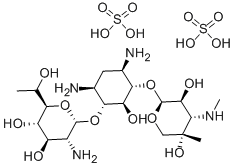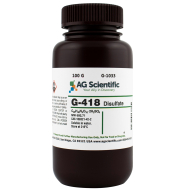G-418 (Geneticin) is an aminoglycoside antibiotic similar in structure to gentamicin B1. It is produced by Micromonospora rhodorangea. G418 blocks polypeptide synthesis by inhibiting the elongation step in both prokaryotic and eukaryotic cells.
 G-418 (Geneticin) is an aminoglycoside antibiotic similar in structure to gentamicin B1. It is produced by Micromonospora rhodorangea. G418 blocks polypeptide synthesis by inhibiting the elongation step in both prokaryotic and eukaryotic cells. Resistance to G418 is conferred by the neo gene from Tn5 encoding an aminoglycoside 3'-phosphotransferase, APT 3' II. G418 is commonly used in laboratory research to select genetically engineered cells (typically using the KanMX selectable marker). In general for bacteria and algae concentrations of 5 mg/L or less are used, for mammalian cells concentrations of approximately 400 mg/L are used for selection and 200 mg/L for maintenance. However, optimal concentration for resistant clones selection in mammalian cells depends on the cell line used as well as on the plasmid carrying the resistance gene, therefore antibiotic titration should be done to find the best condition for every experimental system. Titration should be done using antibiotic concentrations ranging from 100 mg/L up to 1400 mg/L. Resistant clones selection could require from 1 to up to 3 weeks.
G-418 (Geneticin) is an aminoglycoside antibiotic similar in structure to gentamicin B1. It is produced by Micromonospora rhodorangea. G418 blocks polypeptide synthesis by inhibiting the elongation step in both prokaryotic and eukaryotic cells. Resistance to G418 is conferred by the neo gene from Tn5 encoding an aminoglycoside 3'-phosphotransferase, APT 3' II. G418 is commonly used in laboratory research to select genetically engineered cells (typically using the KanMX selectable marker). In general for bacteria and algae concentrations of 5 mg/L or less are used, for mammalian cells concentrations of approximately 400 mg/L are used for selection and 200 mg/L for maintenance. However, optimal concentration for resistant clones selection in mammalian cells depends on the cell line used as well as on the plasmid carrying the resistance gene, therefore antibiotic titration should be done to find the best condition for every experimental system. Titration should be done using antibiotic concentrations ranging from 100 mg/L up to 1400 mg/L. Resistant clones selection could require from 1 to up to 3 weeks.
| 1. Antiviral activity of geneticin(G-418) against dengue virus. |
| The aminoglycoside, geneticin (G418), was recently shown to have antiviral activity against bovine viral diarrhea virus (BVDV). Since BVDV, dengue virus (DENV) and yellow fever virus (YFV) all belong to the Flaviviridae family, it seemed possible that a common step in their life cycle might be affected by this aminoglycoside. Here it is shown that geneticin prevented the cytopathic effect (CPE) resulting from DENV-2 infection of BHK cells, in a dose-dependent manner with an 50% effective concentration (EC(50)) value of 3+/-0.4microg/ml. Geneticin had no detectable effect on CPE caused by YFV in BHK cells. Geneticin also inhibited DENV-2 viral yield with an EC(50) value of 2+/-0.1microg/ml and an EC(90) value of 20+/-2microg/ml. With a CC(50) value of 165+/-5microg/ml, the selectivity index of anti-DENV activity of geneticin in BHK cells was established to be 66. Furthermore, 25microg/ml of geneticin nearly completely blocked plaque formation induced by DENV-2, but not YFV. In addition, geneticin, inhibited DENV-2 viral RNA replication and viral translation. Gentamicin, kanamycin, and the guanidinylated geneticin showed no anti-DENV activity. Neomycin and paromomycin demonstrated weak antiviral activity at high concentrations. Finally, aminoglycoside-3'-phosphotransferase activity of neomycin-resistant gene abolished antiviral activity of geneticin. |
| 2. Antiviral activity of geneticin(G-418) against bovine viral diarrhoea virus. |
| Aminoglycoside G418 is commonly used to generate stable replicons for RNA viruses, such as hepatitis C virus, West Nile virus, and bovine viral diarrhoea virus (BVDV). This precludes testing 6418's own antiviral activities against those viruses. Antiviral activity of G418 could result from interference with either the assembly or release of active virus, rather than the regulation of viral translation and replication. Thus the use of chemical analogues of G418 as antiviral therapeutics for treatment of viral diseases associated with the Flaviviridae family, such as hepatitis C virus, dengue virus, yellow fever virus, West Nile virus and others. |
| 3. Programmed cell death in Entamoeba histolytica induced by the aminoglycoside G418. |
| Morphological and biochemical evidence of programmed cell death (PCD) in Entamoeba histolytica induced by exposure of trophozoites to the aminoglycoside antibiotic G418. Morphological characteristics of PCD, including cell shrinkage, reduced cellular volume, nuclear condensation, DNA fragmentation and vacuolization were observed, with preservation of trophozoite membrane integrity. PCD is orchestrated biochemically by alterations in intracellularion fluxes. In G418-treated trophozoites, overproduction of reactive oxygen species (ROS), decreased intracellular K+, increased cytosolic calcium, and decreased intracellular pH levels were observed. However, externalization of phosphatidylserine was not detected. These results suggest that amoebae can undergo PCD under stress conditions, and that this PCD shares several properties with PCD reported in mammals and in a variety of unicellular organisms. |
4. Translational readthrough by the aminoglycoside geneticin (G-418) modulates SMN stability in vitro and improves motor function in SMA mice in vivo
Geneticin (G418) was identified as a potent inducer of the 7-SMN target sequence in vitro through a novel quantitative assay amenable to high throughput screens. Subsequent treatment of patient cell lines demonstrated that G418 increases SMN levels and is a potential lead compound. Furthermore, treatment of SMA mice with G418 increased both SMN protein and mouse motor function. Chronic administration, however, was associated with toxicity that may have prevented the detection of a survival benefit. Collectively, these results substantiate a sequence independent role of SMN's C-terminus in protein stability and provide the first in vivo evidence supporting translational readthrough as a therapeutic strategy for the treatment of SMA.
5. A mouse model for nonsense mutation bypass therapy shows a dramatic multiday response to geneticin
Application of IQSCMaRTEA reveals that geneticin is much more efficacious in vivo than gentamicin. Treatment with geneticin elicits a multiday response, and residual F9 antigen can be detected after 3 weeks. These data demonstrate the utility of IQSCMaRTEA for evaluating drugs that bypass nonsense mutations. In addition, IQSCMaRTEA may be helpful for testing inhibitors of nonsense-mediated decay, as stop codon management therapy will sometimes require inhibition of nonsense-mediated decay and translational bypass of the nonsense mutation. Furthermore, geneticin, its metabolites, or better tolerated analogues should be evaluated as a general treatment with multiday response for severe genetic disease caused by nonsense mutation.
6. Crystal structure of geneticin(G-418) bound to a bacterial 16S ribosomal RNA A site oligonucleotide.
Aminoglycosides are antibacterial molecules that decrease translation accuracy by binding to the decoding aminoacyl-tRNA site (A site) on 16S ribosomal RNA. We have solved the crystal structure of an RNA fragment containing the A site bound to geneticin at 2.40A resolution. Geneticin, also known as G418, is a gentamicin-related aminoglycoside: it contains three rings that are functionalized by hydroxyl, ammonium and methyl groups. The detailed comparison of the distinctive behaviour of geneticin (binding to pro- and eukaryotic A sites) with the crystallographic, biochemical and microbiological results obtained so far for aminoglycoside-A site complexes offers new insights on the system. The two sugar rings constituting the neamine part common to most of the aminoglycosides bind to the A site, as already observed in the crystal structures solved previously with paromomycin and tobramycin. The essential hydrogen bonds involving ring I (to A1408) and ring II (to the phosphate oxygen atoms of the bulged adenine bases 1492 and 1493 and to G1494) are conserved and additional contacts are observed from ring III (to phosphate oxygen atoms of G1405 and U1406). The present work illustrates a molecular basis of the range in sensitiveness exhibited by geneticin towards common point A site mutations associated to resistance phenotypes. In addition, analysis and comparisons of the structures cast light on the role played by the conserved U1406.U1495 pair in the recognition of the A site by aminoglycosides.
7. Establishment of a novel human squamous cell carcinoma cell line from oral primary tumor by geneticin(G-418) treatment.
A novel cultured cell line NOS-1, derived from a human oral primary squamous cell carcinoma (SCC) of the lower gingiva, was established without xenografting the tumor into nude mice by means of "Geneticin" treatment, which allowed for elimination of contaminated fibroblasts and produced enriched tumor cells at an early stage of the culture. NOS-1 cells showed numerous desmosome structures and some intermediate filaments. To determine tumorigenicity and to establish an orthotopic tissue invasion model for oral carcinoma, the NOS-1 cells were injected into the back and the tongue of male athymic nude mice. The back tumors showed an expansive growth pattern without significant invasion of surrounding tissues, while the tongue- implanted tumors exhibited invasive growth. The establishment of a novel oral primary tumor cell line and a new orthotopic tissue invasion model is expected to be useful for the study of biological characterization and for the identification of the invasive mechanism of human oral cancers.

SOURCES:
1. Translational readthrough by the aminoglycoside geneticin (G418) modulates SMN stability in vitro and improves motor function in SMA mice in vivo. Christopher R. Heier1, et al.
2. A mouse model for nonsense mutation bypass therapy shows a dramatic multiday response to geneticin. Chunmei Yang, Jinong Feng, et al.
3. Antiviral activity of geneticin against dengue virus. XG Zhang, PW Mason, et al. Antiviral Res, July 1, 2009; 83(1): 21-7.
4. Antiviral activity of geneticin against bovine viral diarrhoea virus. AV Birk, EJ Dubovi, et al. January 1, 2008; 19(1): 33-40.
5. Crystal structure of geneticin bound to a bacterial 16S ribosomal RNA A site oligonucleotide. Q Vicens and E Westhof. J Mol Biol, February 28, 2003; 326(4): 1175-88. 6. Establishment of a novel human squamous cell carcinoma cell line from oral primary tumor by geneticin treatment.ZW Ji, N Oku, et al. Kobe J Med Sci, June 1, 2000; 46(3): 137-45.
7. Programmed cell death in Entamoeba histolytica induced by the aminoglycoside G418
J. D Artagnan Villalba,Consuelo Gomez, et al.
8. Wikipedia.

